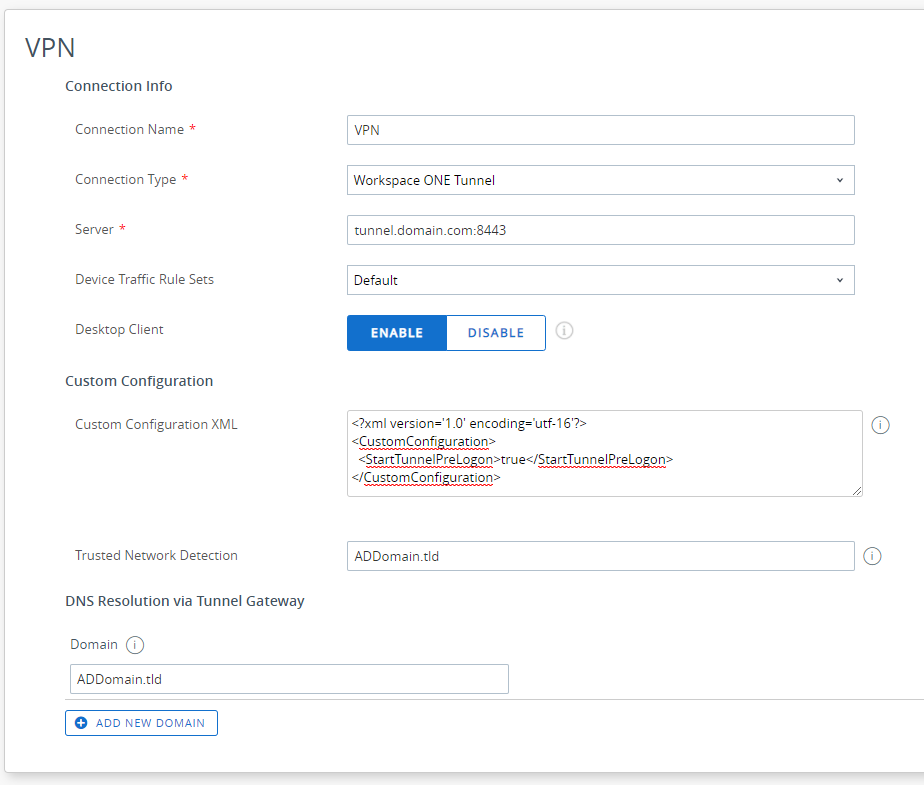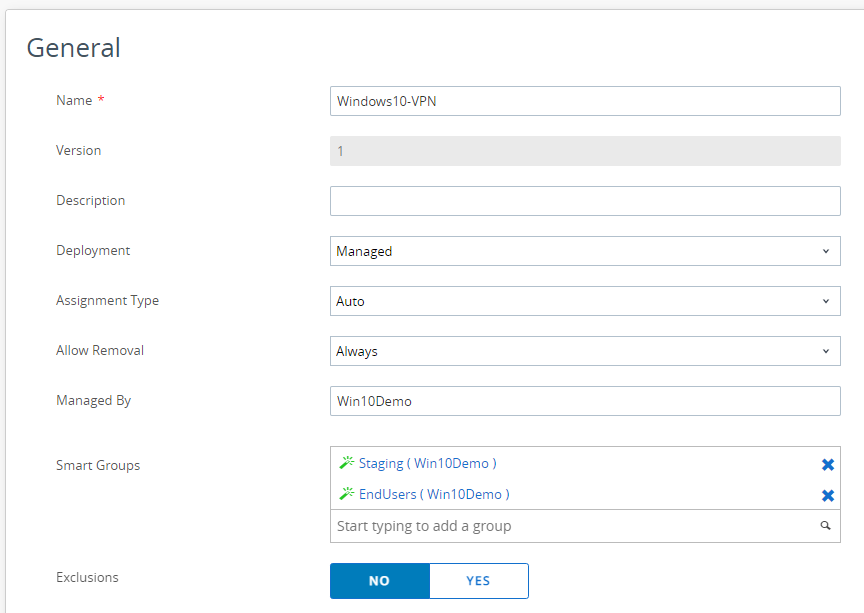Domain Authentication with Tunnel PerApp VPN
Story
On Windows when an administrator wants to join a machine to the domain, Microsoft provide 2 solution:
- Online domain join, since Windows 2000, requires to be on the same network of a domain controller, often mentioned as “domain join”.
- Offline domain join, since Windows 7 via command line and Windows 10 1709 via CSP, allow a machine to join the domain without the need to be on the network.
There is no difference between a machine which have join online Vs offline. More info: https://debay.blog/2020/08/12/windows-10-join-method-overview/
Offline Domain Join Process
In the MDM world Offline domain join allow users to join the domain from home, with the Dell Connected provisioning this can even be done in factory.
Manual Process
1. Blob generation
2. Copy the blob onto the machine
3. Admin/User execute the domain join command
MDM Process
1. Blob generation
2. Blob send via SyncML
3. CSP execute the domain join command
User first logon issue
Once the machine is domain join, the next step is for the user to logon for the first time. At this point in time, there is no other way but to have a line of sight with the domain controller, there no Windows mechanism to allow this first logon to be offline.
To be able to do it outside of the domain network a VPN is required. This VPN needs to either be a machine VPN or have to be enable on the logon display, it is often referred to Gina VPN because gina was the name of the interface handling the logon and authorization process back in XP.
VMware Tunnel and Domain Authentication
VMware Tunnel is the VMware VPN solution part of Workspace ONE. It is a per app VPN which allow to only tunnel the application which should be on the VPN.
As mentioned before, the VPN needs to run before the user logon, this is possible since 2.0.2 with the following Custom Configuration.
<?xml version='1.0' encoding='utf-16'?>
<CustomConfiguration>
<StartTunnelPreLogon>true</StartTunnelPreLogon>
</CustomConfiguration>User Logon Process
Authentication
The process responsible for the User logon is lsass.exe, it is listed in the Windows Services as Netlogon service. It maintains a security channel between the computer and the domain controller to authenticate user and services.
It use the following network communication flow:
| Application protocol | Protocol | Ports |
|---|---|---|
| NetBIOS Datagram Service | UDP | 138 (Optional, used for WINS resolution) |
| NetBIOS Name Resolution | UDP | 137 (Optional, used for WINS resolution) |
| NetBIOS Session Service | TCP | 139 (Optional, used for WINS resolution) |
| SMB | TCP | 445 |
| LDAP | UDP | 389 |
| RPC¹ | TCP | 135, random port number between 49152 – 65535 |
The lsass also use Kerberos for the authentication
| Application protocol | Protocol | Ports |
|---|---|---|
| Kerberos | TCP | 88 |
| Kreberos | UDP | 88 |
| DC Locator | UDP | 389 |
GPO
Part of the user logon is the application of the user GPO, while this is not ideal to mix CSP and GPO, it is often the case that domain specific GPO are still in the mix. To support GPO synchronization, System need to be added to the Device Traffic rules, this will allow access to the network share where the GPOs are located, i.e: SYSVOL. However GPO also rely on RPC communication as well and the service running the GPO is svchost. As svchost is a generic executable for Windows services it is not advised to add the process in a Device Traffic rule.
Service Name: Group policy client
Command line: %systemroot%\system32\svchost.exe -k netsvcs -p
| Application protocol | Protocol | Ports |
|---|---|---|
| DCOM | TCP + UDP | random port number between 49152 – 65535 |
| LDAP | TCP | 389 |
| SMB | TCP | 445 |
| RPC | TCP | 135 random port number between 49152 – 65535 |
Domain Action Possible
This configuration bring the following support:
- User First logon and subsequent
- GPO
- Password Change for users
- Share folder access
- Printer access
- mmc access to the domain is possible too : require mmc to be on the list of apps
Tunnel Configuration
Device Traffic Rules
Create the following Device Traffic Rules
| Application | Action | Destination | Purpose |
|---|---|---|---|
| C:\WINDOWS\system32\lsass.exe | TUNNEL | Active Directory Domain. e,g: *.addomain.tld | User Logon Process. Service Name: NETLOGON |
| System | TUNNEL | Active Directory Domain. e,g: *.addomain.tld | Share access for GPO. i.e: SYSVOL |
| C:\Windows\explorer.exe | TUNNEL | Active Directory Domain. e,g: *.addomain.tld | Multi |
| C:\WINDOWS\system32\svchost.exe | TUNNEL | Active Directory Domain. e,g: *.addomain.tld | GPO Process. Service Name: Group Policy Client |
Device Profile
Add a new VPN profile for Windows Desktop. With the following configuration:
- Server: filled automatically
- Default Traffic Rule Sets: Select the Device Traffic Rules created before
- Desktop Client: Enabled
- Custom Configuration:
<?xml version='1.0' encoding='utf-16'?>
<CustomConfiguration>
<StartTunnelPreLogon>true</StartTunnelPreLogon>
</CustomConfiguration>- Trusted Network Detection: enter the FQDN of the AD Domain of the user, this setting allow Tunnel to detect if the machine is already on the corp network.
- Domain: FQDN of the AD Domain and any other domain that needs resolution via VPN
Assign it to the Staging User and the End User via Smart Groups and make sure that the assignment is at Auto
Now everything is ready for the End User to open the session without the need to be on the network.
vExpert, blogger and VMware champion. Worked as a Microsoft consultant for a partner before joining VMware via Airwatch in 2015.

